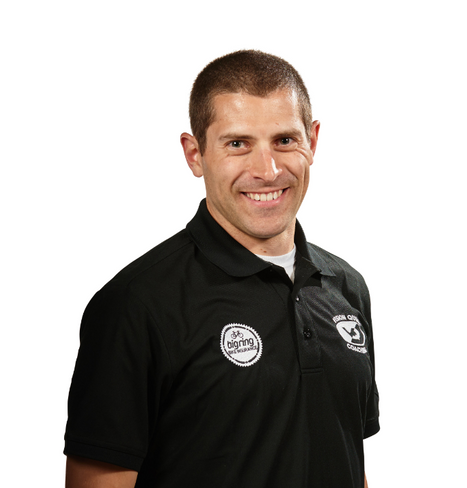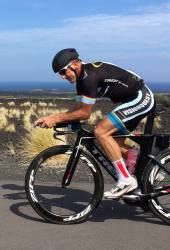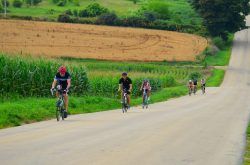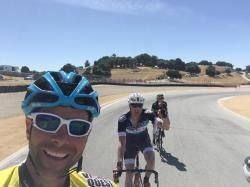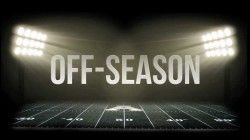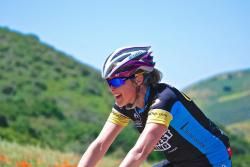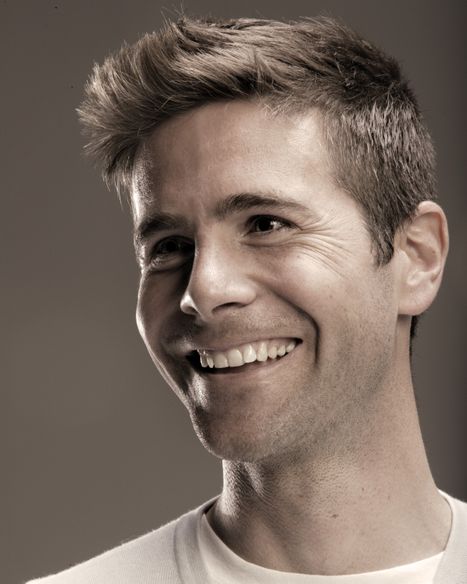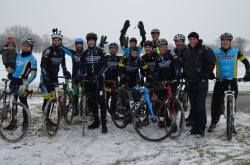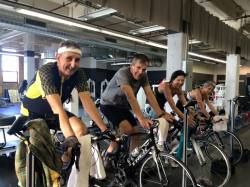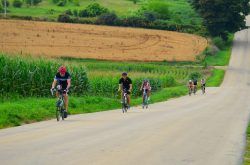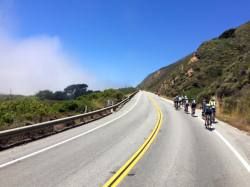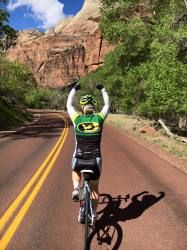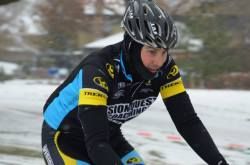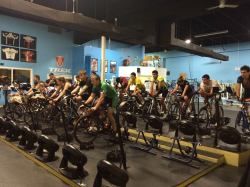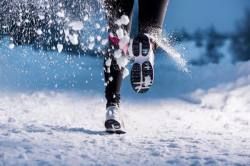Cycling & Training Articles
The Hollow Hold Progression
Jessica Stroup
The Hollow Hold is a functional core position that is seen in many different exercise movements and athletic training programs. The position itself can be used as an isometric exercise or as a bracing technique during dynamic movement.
For those who are not familiar with the hollow hold position or are unable to maintain the position, there are variations of this exercise that can help develop the proper strength and technique to eventually be able to perform a hollow hold.
moreTime to Test?
By Dr. Kevin Sprouse
Physiologic testing is one of the most valuable and undervalued tools available to athletes. Objectively characterizing one’s fitness can provide the data necessary to create a training program which is the most effective and efficient possible. Whether you are a professional or recreational athlete, training efficiency is massively important! If you spend ten hours per week training, you would hope to get the maximum benefit from every one of those ten hours. The same holds true if you spend thirty hours per week riding or running. Everyone’s time is limited, and no one wants to waste that time on ineffective training.
If you have undergone testing in the past, then regular retesting serves to objectively evaluate your training plan, your progress, and whether changes need to be made. If you’ve not tested previously, then setting a baseline is invaluable for moving forward in the most efficient manner.
So, what should you be testing? And is it safe to do this testing during a pandemic?!?
Endurance athletes are often familiar with the concepts of VO2max and lactate threshold. Let’s quickly look at each of these and the manner by which we measure them.
moreHow To Do Strides In Your Run Workouts
By Ron Dorneker
We incorporate some strides into the warm-ups of our workouts. Here is a good description of what strides are and how to properly perform them.
Strides – or accelerations – are a staple of almost every high school, university, and professional running team. Whether you’re an 800m specialist, cross country runner, or an aspiring marathoner, strides are a fundamental building block of speed and coordination.
But the majority of recreational runners never do them despite a host of benefits. What are strides? Strides are also known as striders, stride-outs, or accelerations.
- They’re about 100m accelerations where you start at a jog, build to about 95% of your max speed, and then gradually slow to a stop. One stride should take you about 20-30 seconds depending on your ability.
- Take about 40-60 seconds of walking or standing in between each stride to catch your breath. Running strides is not an aerobic workout so don’t rush them – you get zero additional benefits by shortening the recovery period!
- In fact, it’s best to think of strides as a speed development workout. The goal is not aerobic development, endurance, or getting in “a good workout.” Rather, it’s turnover and building comfort at high speeds.
Off Season Challenge: Week 9 Core Circuit
Want to become a faster cyclist? Strengthen your core! Want to be a faster runner? Strengthen your core! Want to be proactive in avoiding injury? STRENGTHEN YOUR CORE!
We know you all have been prioritizing strength during the Off-Season Challenge and have developed a stronger foundation, (who hasn't forgotten the squat challenge?!), but let's give some highlighted focus this week to the powerhouse of the body--the CORE! To be clear, when referring to the core in this case, we are talking about the abdominals, back, glutes, and abductors and adductors. Provided for you is a “Core Circuit” with links that demonstrate the exercise that you can do anywhere, as well as a couple alternates or options if needed.. Go through the circuit once a day and not only earn your points, but to bask in all the glory of the steps you are taking to improve all aspects of your functional life! BAM!
Go through this list of exercises below, doing 1-3 rounds, depending on your time and fitness, of course using care and caution. When in doubt, skip an exercise if you have any concerns or pain is associated with any of the movements. Get a weekly challenge point for each day you complete this core circuit.
moreBenefits of Adding Squats to Your Routine
Some fitness experts recommend the squat as the one exercise people should do every day if they had no time for anything else. “50 squats a day will keep the doctor away—seriously,” Dr. Christopher Stepien, a sports therapist and chronic pain expert said. “Daily squats will help you mentally and will even give you better yearly check-ups with your primary physician.”
The most obvious benefit of squats is building your leg muscles – quadriceps, hamstrings, and calves. These drills also create an anabolic environment, which promotes body-wide muscle building, improving muscle mass.
Squats, and all of their variations, are a great exercise for the whole body. This is a good move if you want to burn fat.
moreFinding Inspiration in Unlikely Places
By Jason Schisler, Director of Coaching
Normally, you might expect to turn to this column for some in-depth dissection and practical application of training principles. This time, it will tend toward something a bit more personal, but my hope is this can still provide insight about how you might find inspiration in your own endeavors. The subject will be the thinking that led to the recent completion of a pretty long run. Read on to find out more!
After spending almost 20 years in endurance sports, I’ve had the opportunity to take part in a lot of different activities: road racing, cross racing, time trials, mountain biking, skate and classic cross country skiing, running events from 5k to 50 miles and, once, even a kayak race. Most of the events I did weren’t especially notable, generally local races with small to medium fields. A lot of the VQ athletes have competed in much more prestigious events, things like various Ironmans, Leadville, the Boston Marathon and Lotoja come to mind--and I haven’t done any of them.
When I raced on the bike, it was all about head-to-head competition. To borrow a line from Talladega Nights’ Ricky Bobby, “If you’re not first, you’re last.” But that challenge lost its appeal to me, and as I moved into skiing and running, there was still some competition against the field, but my motivation came more from pushing myself harder than I’d pushed before. Eventually, I reached a point where I was satisfied. I had found the maximum that I felt I could achieve for the amount of work I was willing to put in.
moreIntegration of Modern Training Technology with Traditional Training Methodology
By Jason Schisler, Director of Coaching
Technology everywhere has come a long way, even in the lifetimes of the youngest readers here. Nearly all of us walk around with a computer in our pockets more powerful than what was available to the average homeowner 25-30 years ago. Cars don’t always need gas and soon may not even need drivers. Eventually, just as the Jetsons foretold, they might even be flying. Training for endurance sports has certainly not been lacking in innovation during this time. Power meters have become nearly ubiquitous (and arguably a necessity) in cycling, along with making in-roads to the running world. Indoor training technology and diversity has skyrocketed, with multiple platforms available in the interest of providing a better and more precise user experience. Does this mean the methods of the past are no longer valid? Certainly not! And here, we’ll explore some ways you’ll want to blend modern technology with old-school methods to optimize your results and understanding.
Let’s start with the power meter. Its development, acceptance and, now, prevalence has truly revolutionized the way we approach cycling training. Seeing power on our handlebars in real time was the first opportunity we had to objectively compare the work we did from one ride to another. The fundamental math of watts and kilojoules allowed us to quantify training like we never had before, and some of the spinoff calculations like Normalized Power, Intensity Factor and TSS have further refined the language that coaches use to plan workouts and communicate with athletes. From a coach’s standpoint, it can be very challenging to accurately assess an athlete’s performance in training, see progress over time or develop a race strategy for certain types of events without power, especially if you don’t interact with that athlete face-to-face all the time. There are now so many different power meters on the market across a wide range of price points, I would consider them a critical purchase for anyone serious about optimizing their training.
moreStart with Simple
By Jason Schisler, Director of Coaching
My columns are often focused on some way that you can optimize your training, often in terms of fitting it in, balancing the workload or analyzing your data. While those things are helpful for athletes with some training history, if you’re at the newer end of the spectrum, you may still be overwhelmed by the whole process, let alone the terminology. Chances are you got into endurance sports because there was some appeal, whether fitness, fun or something else altogether. You might find yourself frustrated trying to understand or figure out the best path forward. My advice: start with what’s simple.
There are certain undeniable necessities to endurance sports: a bike and helmet for instance, running shoes, access to some body of water (indoors or out), appropriate clothing for the given activity, etc. Beyond that, there are many other gizmos and accessories that can be added to the top of the pile--and they may well improve the experience--but aren’t absolute necessities. Cycling shoes are a good example. They are certainly nice to have and accessible enough that they probably aren’t worth forgoing, but it is technically possible to ride a bike without them.
moreWhy Sweet Spot?
Jason Schisler, Director of Coaching
A common thread in many of our early-season workouts is Sweet Spot training. There are many benefits to this type of work, but the primary reason we include it is because it offers most of the benefits of threshold training while allowing for faster recovery over threshold work. Despite this, it seems many athletes find these workouts quite challenging, so this article will lay out what Sweet Spot is, what it does and how to get the most benefit from this type of training.
First, what is Sweet Spot all about? Training zones don’t have firm start and stop points; the top end of one range overlaps the bottom of the next. While the goal often may be to train in the middle of a target range, Sweet Spot is a bit different. You want to target the transition point between tempo and threshold. Different training models will express this differently, one says Sweet Spot happens at 83-97%, another recommends 88-92%. This variation is likely part of the confusion. Looking at these numbers, the average athlete can span a pretty large power range, 30-35 watts.
Rather than worrying about these ranges, I like to define Sweet Spot as 90%. It is right in the middle of both of these ranges and fits well between the most accepted ranges used for tempo and threshold. It’s also much easier to remember one number in training, rather than the upper and lower ranges of a zone. In addition to that, Sweet Spot is about feeling. The effort should be hard, but noticeably easier than doing threshold work.
moreHow Does Cyclocross Benefit Road Cyclists?
You may be wondering how you as a dedicated roadie can benefit from the sport of cyclocross. There are many reasons, some compelling, and some just fun!
Variety
The first great reason for a roadie like yourself to test out the cyclocross waters is simply because cyclocross is a great change of pace from the day to day road riding scene. Tired of hanging out with the same guys, meeting at the same coffee shop, and riding the same old road routes over and over? Cyclocross allows you to take a break from all that, and get to know a whole new group of cycling fanatics. It may also allow you to beat up on some of the strong men on the road who may not be quite as strong when the rubber leaves the asphalt. Cyclocross will also give you a new appreciation for those parks that you fly by in the peloton and barely even notice. Who'd have known that such a little patch of grass could cause such a world of pain?
Seasonal Motivation
A second great way that roadies will benefit from cyclocross is most noticeable for those of us who live in areas that have a distinct winter season. To a pure roadie, the approach of winter often causes a reduction in road miles and intensity and a move into hibernation mode. This is often due to decrease in daylight, and the inclement weather conditions often associated with the winter months. However, having a fall/early winter cyclocross race series to train for is extra motivation to keep pounding those pedals well after the temperature drops and the nights get longer. In fact, it's so inspiring that you have to be careful of overtraining and not getting proper rest between the seasons! For those who don't have a distinct winter season, cyclocross provides a nice break from year-round road riding, even if the weather allows for it.
morePractice Makes You Perfect…or at Least Better
Jason Schisler, Director of Coaching
Endurance sports and competition require a lot of practice. The amount of time spent preparing for even a single event dwarfs the actual duration of the event. This huge volume of training is necessary, not only to develop the physical reserves to handle the demands of the event, but also to train the body in efficient movement patterns to maximize economy. When it comes to competition, it’s never quite the same as training.
While it’s certainly possible to prepare yourself to complete a century, a triathlon or even a 5k, when you begin to move along the spectrum from completing to competing (for the win, against your age group or even against your own previous performance), a more advanced skill-set needs to be developed. The only way to really do this is through practice. In mass-start bicycle racing--track, criterium, road, cyclocross and mountain bike--there is a lot to keep track of and the mind must be constantly alert. Focus can be narrowed a bit in individual competitions such as time trials, triathlons and running events, but achieving your best still requires a careful balance of many variables. Psychology addresses the four stages of competence:
- Unconscious incompetence (not knowing what you need to do)
- Conscious incompetence (knowing what you need to do, but not being able to do it)
- Conscious competence (knowing what you need to and being able to do it with focus)
- Unconscious competence (knowing how to do what you need to do without thinking about it)
Dealing with Training Interruptions
Jason Schisler, Director of Coaching
Training consistently is one of most important components of sustained athletic growth.
However, it is the rare working athlete who can make it through an entire season without some interruption. For some athletes, planned vacations or work-related travel may get in the way, and figuring out a plan of attack in these situations is relatively manageable. The more challenging interruptions are those that creep up unexpectedly such as long days at the office, sudden trips, changing family obligations or illnesses and injuries. The goal of this article is to offer practical solutions to a few of the situations that can keep athletes from the consistent routines they strive for.
The easiest interruptions to deal with are those that you see coming. Planned trips offer a greater opportunity to organize trip logistics so that the impact on your training is minimal. If you know you will be spending some time away from your bike or a pool, you may be able to adjust your training ahead of time to include a bike or swim focus, allowing you to use the time away as recovery from training stress. Extended travel may compromise your training over a longer timeframe, but is also less likely to be a high-pressure trip where you’re busy all day. Some investigation into local options may yield a pool that’s close enough to get a brief workout in, or even a bike shop that offers rentals.
moreTen Tips for a Successful Outdoor Road Season, Part 2
The outdoor road season has finally arrived! Now that you've moved your ride outside, make sure you maintain your focus on safety!
First a review…
1. Bike Check
- Ideally, have your bike checked by a professional mechanic
- If you’re taking on the bike check yourself, your goal is just to make sure everything is working properly
- Drop your bike, listen for rattling sounds
- Check tires for tread and air pressure
- Ensure there is enough “meat” on brake pads
- Are your skewers tight?
2. Obey Road Signs
- Put your foot down at stop signs
- Remain stopped until light turns green
- Use your best judgment; some things cannot be avoided/adhered to but the traffic laws are there to protect everyone on the roadways
3. Head Up!
- Don’t look at your wheel
- Don’t look at the next bike’s wheel
- Look ahead and you’ll avoid accidents!
- Seeing what’s coming provides the ability to anticipate and avoid danger
- Bonus: you’ll draft closer, hold a straighter line and still see what’s below you via peripheral vision
4. Communication is Key!
moreTen Tips for a Successful Outdoor Road Season, Part 1
The outdoor road season is quickly approaching! Maybe you’ve already gone for your first outdoor ride, maybe you’re starting to get the itch. Your ultimate goal? Safety!
1. Bike Check
- Ideally, have your bike checked by a professional mechanic
- If you’re taking on the bike check yourself, your goal is just to make sure everything is working properly
- Drop your bike, listen for rattling sounds
- Check tires for tread and air pressure
- Ensure there is enough “meat” on brake pads
- Are your skewers tight?
2. Obey Road Signs
- Put your foot down at stop signs
- Remain stopped until light turns green
- Use your best judgment; some things cannot be avoided/adhered to but the traffic laws are there to protect everyone on the roadways
3. Head UP!
- Don’t look at your wheel
- Don’t look at the next bike’s wheel
- Look ahead and you’ll avoid accidents!
- Seeing what’s coming provides the ability to anticipate and avoid danger
- Bonus: you’ll draft closer, hold a straighter line and still see what’s below you via peripheral vision
4. Communication is Key!
moreThe "Off Season"
By Robbie Ventura, VQ Founder
I don't think there really should be such a thing for amateur athletes. To me, the off-season is about keeping your fitness, not losing it. After I finished my career as a pro cyclist, I still trained pretty hard in the spring and summer and thought I needed to take time off in the winter like I did when I raced professionally. I started to realize that the more time I took off, the harder and longer I had to work in the winter/spring to get myself back to where I was at the end of the season before. As I got older and trained less, I learned that I did not need a break from working out, but I did need something. That something ended up being quite simple. What I needed was a change!
Most of us do not do enough overall training volume to warrant taking time off. Now I know some of you are thinking, "I work out over ten hours a week all summer and I need a break". Yes and no. You may need a break from running, cycling or swimming, but you do not need a break from working out. While it's true that at 10 or even 15 hours a week you are working out a bunch, that is nothing compared to the professionals who work out over 25 to 30 hours, week in and week out. After that much overall stress, their bodies really do need a break from exercise. Their bodies are on the razor's edge of overtraining all the time and they need a period of detraining to allow the body chemistry to regenerate and relax. A professional's time off is about allowing a bit of rest to the systems that have been overworked for so long, thereby allowing some deep healing.
moreOff Season and Out of Season Goals
Training for any race or event goal is complex. There are some significant additional factors to consider any time you have a goal on your calendar that falls outside the traditional “season” for endurance sports. Depending on your location, the season usually begins in March or April and continues until September. For the sake of this article, we’ll consider anything outside of this time frame either off-season or out-of-season.
There is a crucial distinction between these two terms, and as a result, each will need to be approached differently. Off-season goals are those that are not central to your overall training and racing ambitions. In most cases, these goals simply fuel the competitive fire. Such goals are worthwhile because they make it easy to get a dose of high-intensity training without the psychological stress of an interval session. While it is important that your training be at a level to support your participation in the event, in general there is no need to make any modifications to your regular training routine.
Setting an off-season goal in an entirely different sport can be a good idea as well. It will motivate you to spend some time on an entirely different activity, making use of muscles and movement patterns that have been neglected during your main racing season. Although you may have a specific performance ambition for the event, it is important that the majority of your focus be on the process leading up to the goal rather than the actual outcome.
moreDexaFit: Helping You to Set Goals for Next Season
VQ Coach Nan Doyal
At the end of a long season it is time to rest, recover and regroup. It’s time to transition off the road bike and onto the cross bike. It’s when I go back to the gym to work on strength, start running and skiing again and have more time to hang out with friends and family. It is also the time when, like other athletes at Vision Quest, I reflect on the season I’ve finished and set my goals for the year ahead both in terms of events and what parts of my fitness I am going to focus on improving. If weight loss is my goal, it is the perfect time to do it because I am not asking as much of my body as I do in-season (and with the impending temptations of holiday food, it’s always helpful to have a goal backing you up when turning down a second piece of pumpkin pie). This year I made the decision that once and for all I was going to lose those few extra pounds that I was lugging up climbs that my competition wasn’t.
Body weight is the number we’ve all been conditioned to look at. It is the metric which traditionally tells us if we are getting fatter or thinner. It is the number that athletes plug into their Power/Weight ratio. That magic number that tells us how potentially fast we are relative to people who are twice or half our size. It’s the number I focus on when I am training to race. The higher my power/weight relative to the others, the faster I will be able to go up those climbs.
moreOff Season Challenge 2017
By Robbie Ventura, VQ Founder
For the last three months, Vision Quest members have been participating in the first annual VQ Off-Season Challenge (OSC). I am happy to report that it was a huge success on many levels.
For many endurance athletes, the off-season can be a confusing time. Some athletes need a big rest--physically, mentally or sometimes both. Others don't need much rest at all. This might stem from different physical needs like healing or needing to build strength. All of us need to focus on body composition and the off-season is a great time for this. Needs vary from athlete to athlete with some needing to build muscle, some needing to lose fat and others needing a combination of both. Then there are the athletes who have low bone density and need more weight-bearing activities. I think it is safe to say that everyone can improve something as it relates to body composition. Since this is the one thing we can all work on, we decided to do a challenge around it and thus, the Off-Season Challenge was born.
All the participants started the journey with a Dexa Scan in October. A Dexa Scan provides extremely accurate measurements of lean muscle mass, body fat and bone density. These scans provided a baseline for the challenge. Individuals were then placed on one of four teams. Each team had a team captain who motivated and educated team members and kept everyone on target. Team members earned points for completing various things like strength training, endurance workouts, good nutrition, a weekly reflection, etc. We also had challenges that varied from week to week. These included goals of better sleep, better hydration, dally push-up and squat targets and other fun and important daily habits. Finally, we had one “Give Back” challenge each month that included food and toy drives, volunteering at local food banks and completing random acts of kindness. All the challenges focused on developing better habits to help maintain greater intention through a time period that can often prove to be a bit haphazard.
moreHow to Fit in on a Group Ride
Jason Schisler, Director of Coaching
Depending on the type of rider you are and your training background, group rides may make up a large component of your riding at certain times of the year or they may be something completely foreign to you. In the past, we have talked about the advantages and disadvantages of including group rides in the training program for more seasoned riders. Here we will offer some tips to help newer riders find an appropriate group and learn how best to fit into that ride.
If you have never been on a group ride before, you may feel intimidated by the size and speed of the group which may resemble organized (or unorganized) chaos. There are two basic patterns you will encounter on any group ride: 2x2 and rotating paceline.
Riding 2x2 is most practical for lower speeds up to about 22 mph. Two leaders ride side-by-side with the rest of the group lined up side-by-side behind them. The leaders pull for 2 to 5 minutes before pulling off to the outside of their lines and drifting to the back of the group. Simultaneously, the next two riders in line move up between the previous leaders and take up pace-making duties.
When the speed of the group picks up, a rotating paceline becomes a more efficient pattern of locomotion. This too starts with two parallel lines of riders, but instead of riding side-by-side, one line is advancing while the other is receding. As the first rider of the advancing line moves past the first rider in the receding line, he slides over into the receding line and makes his way to the back of the group as other riders in the advancing line continue moving up. When he gets to the back of the group, he accelerates slightly as he moves over to get back into the advancing line and repeats the process over and over. Often, as the pace picks up and riders fatigue, the number involved in the rotation diminishes and there may be a small group of riders riding side-by-side behind the rotating riders in the front. These are usually controlled by a “gate keeper” who maintains a steady gap behind the rotating riders.
moreTricks of the Trade for CompuTrainer Rides
By this time of the season, most of you are probably thinking, “I don’t want to do another CompuTrainer workout”. Unfortunately, the reality is that we have at least another month and quite possibly two during which most of us will be relegated to riding indoors or not at all. Over the years, we have had lots of questions about why things are the way they are during indoor rides, and oftentimes the answer is something simple that has just slipped through the cracks. Other questions persist because certain elements of CompuTrainer function are counterintuitive to normal riding. Our objective here is to bring those items out in the open so that everyone can get the most of their indoor workouts. First, I offer a few points of background information simply to establish context. There are essentially five options you have when riding a VQ CompuTrainer, two manual modes and three connected to the computer. The two manual modes are PROGRAM and ERGO modes. Computer-controlled workouts include Courses, Multi-rider Workouts and ERG Videos. A brief description of each follows:
- PROGRAM: variable resistance settings that can also be controlled with rider gearing
- ERGO: programmable, constant resistance regardless of gearing or pedaling cadence
- Courses: outdoor road ride simulations, anything you can do outdoors you can do here
- Multi-rider Workouts: ERGO-style resistance built into a programmed workout
- ERG Videos: Multi-rider Workouts connected or running alongside video display
Riding Your Fastest Century (Without Getting any Faster)
The lure of a century or 100-mile ride captures the heart of many cyclists. The first one you complete is always a special achievement, and thereafter the goal is often to finish faster and faster. We all know that the fitness progression is not a continually upward trend. It comes with spurts of improvement and plateaus of performance that can become demoralizing. While it’s nice to see the fitness increasing, you don’t always have to look at your fitness level as the sole indicator of performance. Here are some tips to help you shave time off your century without changing your fitness level.
Finding a good group is the fastest way to a quicker finish because it instantly makes the ride 30% easier. However, finding the right group can be a challenge. Even moving fast, a century is a long ride. So you want to be careful not to overextend yourself in the first hour only to find yourself depleted in the last 20 miles. The ideal group should move at a pace close to your fitness level, ride predictably and keep the pace very steady. Faster and more chaotic groups not only waste energy, they create nervous riders and this can tire you out even if you’re not physically fatigued.
moreWhere Do We Use FTP?
Jason Schisler, Director of Coaching
Most have likely encountered the term “FTP” in training parlance. The acronym stands for Functional Threshold Power and refers to maximum effort you could produce over an effort of roughly one hour. In comparison to a laboratory blood lactate test, FTP is a representation of work you can actually do, rather than analysis of physiological markers that correspond to a certain level of performance. FTP is commonly assessed indoors or outdoors through the completion of a 20-minute test. Because sustainable power for this duration will be higher than a full hour, the 20-minute test value is reduced by 5% to determine your FTP training value. The testing process is much maligned because, quite frankly, it’s not very fun. There is a lot of suffering if you are going for a truly maximal 20-minute effort, in both a physical and emotional sense. Many athletes are also reluctant to lay all their cards on the table. Particularly during the off-season when fitness is a bit lower, it can be disheartening to do your best and get a number that’s less than it has been in the past. Removing the emotional connection to a given number and understanding how and where it’s used in your training should help make the testing process a little less daunting. So, how and where do we use FTP?
moreWhat Metrics Matter?
By Jason Schisler, Director of Coaching
For most athletes, we’re now in the “off-season” timeframe. This part of the year is often characterized by less focused training, a less rigid diet and the accompanying loss in fitness and increase in weight. Many are also procrastinating on the start of their indoor training in the hopes that summer will swing back through for one last blast before we succumb fully to the icy chill of winter.
Robbie has talked in the past about how most working athletes don’t really need time off in the off-season because the load they accumulate over the course of the season just isn’t enough to really require a physiological break. Significant losses in fitness can take place in as little as two weeks without training. In a month, fitness can be reduced 20%, and it’s a very precipitous slide from there on. The further fitness drops, the longer it will take to return to your former glory.
While it may be true that most of us don’t really need a full break, a phenomenon I’ve often observed over the years is that even highly motivated athletes hit a bit of a wall around this time of year, after their big events have come and gone. Even though they may not be physically wiped out, it seems they are emotionally fatigued and don’t have the same drive as when building toward their events. This manifests itself in the physical performances. A period of reduced training load and focus can be helpful in resetting during this time. When training becomes work, sports can become less fun. This is an ideal time to get back to what you fundamentally enjoy about swimming, running and cycling.
moreWhat Your Power Meter Has to Tell You
Jason Schisler, Director of Coaching
Throughout the year, but especially during the off-season, you hear Robbie and me talk about setting reference points. We are often talking specifically about supermax testing, which comes around every 8-10 weeks. But if you have a power meter on your bike, every single ride you do becomes a reference point. This doesn’t mean you always have to be working at your limit, but most workouts have something to offer if you’re willing to spend a few minutes a day on post-ride analysis. If you don’t, you might be leaving something on the table in terms of your development as a cyclist, not to mention only getting a small portion of the value out of an expensive power meter.
It’s true that the key reference points everyone should know are those associated with each energy system. We often look at peak sprint power, 4-minute power for the VO2 system, 20-minute power for the threshold system and a steady 3-hour ride for aerobic fitness. These values are useful not only for measuring fitness gains in each system over time, but also as anchor values that will help you make an educated guess on the proper power for intervals of other durations. The first time you perform a new workout, 2-minute intervals for example, you may use the 4-minute test as a starting point.
moreHow Do Gears Work?
Jason Schisler, Director of Coaching
Mechanical advantage: the advantage gained by the use of a mechanism in transmitting force; specifically: the ratio of the force that performs the useful work of a machine to the force that is applied to the machine (from Merriam-Webster Online Dictionary).
The bikes we ride are full of mechanisms designed to increase mechanical advantage. From the balance that comes from the gyroscopic effect of a spinning wheel to the levers that help to manipulate our body’s actions on both the pedals and handlebars, the bike is all about making it easier for us to move faster. More important than anything else is the advantage we are afforded by our gearing.
Apart from fixed-gear and single-speed bikes, most bikes will have a range of gearing options divided amongst one to three front chain rings and an ever-increasing number of rear cogs. Shifters come in many shapes and sizes: combined shifters and brakes on road bikes, downtube shifters on old road bikes, bar ends on time trial bikes and handlebar shifters on mountain bikes. Shifting can be mechanical or electronic. No matter how your system works, the end result is always the same: it allows you to customize your gear ratio to remain as efficient as possible given the current topography.
moreHow Much Should This Hurt?
Jason Schisler, Director of Coaching
Take your pick of cliché statements from motivational posters. In order to improve athletic performance, you have to exceed your previous limits to induce new change. But by how much do you need to exceed those limits? Put another way, how much should it hurt? The stimulus for growth can come from time, intensity or frequency of training. This is only the stimulus. Real growth occurs during recovery as the body responds to the stresses that were placed upon it in an attempt to gird itself against future assaults. If the stimulus imposed is too drastic, or rest is inadequate, you will overwhelm the body’s ability to respond and adapt.
In this article, we’ll take a look at this response on both the micro and macro levels.
Starting small, what should your daily workouts feel like? There is clearly a vast difference between an endurance workout and an intensity session. At low intensities, fuel availability is often the primary limiter. If you persist long enough, muscular fatigue may set in, but it’s likely that in most cases you’ll become bored before this point. An endurance ride should not feel “hard,” but at the same time, it is not necessary for the ride to be completely easy. A good rule of thumb for finding the proper intensity is your ability to converse. If you are able to speak in full sentences, you’re in the right range. Apart from the contact points, there should be little soreness or muscular fatigue at the end of an endurance ride. With appropriate rest and refueling, these can be repeated daily for several consecutive days or even weeks. At the other extreme, high intensity efforts are limited by fuel availability, as well as rate of breakdown and muscular fatigue.
moreA Functional Training Commencement
As summer approaches and I look around at the dwindling bikes and empty CompuTrainers at VQ Chicago, I’m reminded of the words “commencement” and “culmination”. It’s so much like students leaving the classroom in anticipation of what lies ahead this race season. Our little VQers are gussied up in shimmering VQ Gear to head out into the oppressive heat of our Chicago sun, swim at Ohio Street Beach and ride the open country roads. The elements are begging almost as if they too have been waiting for VQers to take what they learned inside and see if they have what it takes to flatten those hills. This is also my time to reflect and see if my Functional Training students have learned anything during our short Fall/Winter/Spring seasons. In FT, we also modeled the cycling phases of Climbing, Endurance, Power and Strength. We train and we train, sometimes without looking at the benefits gained by the most overlooked aspect of endurance training: strength training (or in our case, VQ Functional Training). I know better than most that you can’t strength-train your way into a triathlon race, cycling criterium or any other endurance race (despite the misguided opinions of some CrossFit addicts) because you need to specifically train in the discipline in which you race, be it swimming, biking, running. What I like to hear is how Functional Training has made a difference in the overall conditioning of an athlete and what role it plays in the athlete’s life. I like when my VQers tell me how FT has made a significant physical realization, helping them against others in competition, or how FT has helped them overcome some very serious physical obstacles that would make the most average person sedentary. So I put forth a little discussion with three of VQ Chicago’s regular FT members in the hope that they picked up a little something from FT as they leave me for the summer (kinda) and race to their hearts’ contents. Meet long-time VQer, Dr. Cal Brown (CB), and two newer members, Michael “Porta” Antiporta (MA) and Kjerstin “The J is Silent” Anderson (KA). Here’s some of our discussion:
moreIndoor Training Benefits
Jason Schisler, Director of Coaching
We all ride bikes for different reasons, but mostly for the experience of riding them outside in great weather. With the outdoor weather looking really pleasant, it’s tempting to leave the trainer behind and start doing all of your training outside. Regardless of your goals, continuing to include a ride on the indoor trainer once a week is beneficial to continued forward progress. Here are a few reasons you may not want to put that trainer tire too far out of reach:
- Trainers are more specific: most people have to deal with intersections and variable terrain outdoors, which can make sticking to workout goals challenging. The trainer allows you to dial in your resistance perfectly.
- Trainers are quicker: as a result of the increased specificity and lack of coasting, you can fit the same workout into a shorter timeframe. With longer rides, two hours indoors is comparable to a three-hour outdoor ride.
- Trainers are safer: some athletes’ schedules put them outside in the dark or at times when traffic is heavy. Riding indoors allows you to focus on riding without avoiding potholes or drivers who aren't paying attention.
Keeping Winter Training Interesting
The leaves have fallen, the days have shortened. It’s time to face facts: we’re in the throes of winter.
Cyclists especially may experience a bit of dread at the thought of climbing back onto the CompuTrainers. Triathletes could be a little better off since runs and swims are less affected by weather and light, but they still might question how they’re going to deal with their cycling workouts. By incorporating a few tricks into the winter routine, all athletes should be able to continue training effectively through the colder months and come into the spring season ahead of the game.
One of the most important and often neglected components of endurance performance is movement efficiency. Being the most powerful athlete in a race won’t get you anywhere unless you are able to effectively translate that power to forward speed. The repetitive nature and single-plane movements of endurance sports tend to lead to overuse injuries and lateral muscle weakness and instability. Including two or three weekly functional training classes in your program will help to increase overall strength, allowing your muscles to produce more force, but these classes will also improve core stability and flexibility so that force can be transferred more effectively. Cross-training can be another valuable tool in the winter training repertoire. Including a more diverse range of movements and exercises through new sports promotes increased balance throughout the body to combat the weakness and instability that results from heavy endurance training. Different sports can fill different roles as well. Pick-up basketball or soccer games can serve as informal interval workouts. Cross country skiing and long hikes help to develop the aerobic system. Although the muscles recognize the difference between sports and movements, the cardiovascular system sees all exercise the same way.
moreAre you Training or Just "Working Out"?
Jason Schisler, Director of Coaching
Among exercising individuals, there are basically two types of people: those who are training for some defined goal at a designated future time and those who are merely exercising with a focus on fitness and health rather than performance. There is nothing wrong with being either one of those people, but it is necessary that your training habits align with the camp you have assigned yourself to.
First, let’s define just what is meant in each instance. Training is a purpose-driven endeavor aimed at a specific target and normally both highly rigorous and highly regimented. Working out, on the other hand, is characterized by a more casual and less focused approach to exercise. It is impossible to establish an objective criteria stipulating where we draw the line, as the distinction is more about attitude than volume. It is quite possible that someone who only “works out” exercises more frequently and with greater vigor than another person “trains.” How is this possible, you might ask?
A beginning athlete may be earnestly pursuing his/her first goal, whether it is a bike race, triathlon or century, and has a focused plan designed to work within the constraints of his schedule. Another athlete may be the stereotypical “group ride junkie” or “mileage hound” who rides, runs or does whatever else nearly every day. Even though the latter athlete may be spending more time exercising at a higher overall intensity, he is still just working out because his efforts lack focus.
moreTraining Tips from the Heart: Learn to Listen to Your Body
VQ Coach Joe Wrobel
“Learn to listen to your body.” This is an important training concept at Vision Quest Coaching. What does it mean and in what context is it meant to be used?
Training requires the introduction of a stimulus to the energy system or systems being trained. Generally, this is in the form of an interval of work of various lengths and intensities depending upon the goal. An example: if strength is being trained, a common workout would be 4 intervals of 10 minutes each within a specific power range, pedaling at 50 to 60 rpm, with the low rpm being the key. This is our familiar interval SE.
Further, we know that we cannot train with intensity every day, that the recovery days of no training and/or easier training allow the muscles to rebuild and regenerate to become slightly stronger than before the interval. Train. Recover. Train. Recover. There is only so much intensity that can be exerted over a given period of time. There can be no real training gains without recovery.
But we do not train in a vacuum. We work, we have families, routines become interrupted, we catch colds or the flu, we travel. There are many stressful factors in our lives and these factors can require adjustments in training schedules.
moreHoliday Training
With a packed holiday schedule fast approaching, many people may be finding themselves stretched for workout time. Establishing a consistent routine is essential for those with busy schedules. Even for the busiest among us, there are usually 30 to 60 minutes available at some point during the day where we may be able to sneak in a quick ride or run, or some dynamic strength work. If you are traveling, establishing a routine may be more challenging in an unfamiliar setting. Regardless of your situation, here are some tips to ensure you’re not losing ground:
- Get functional: a high-quality dynamic strength and stability routine can be completed in a very short time. Even if you only have a few minutes here and there, squeeze in a few exercises each time you have a break.
- Be specific: if time is short, make your workouts count by focusing on something specific during the entire session: leg strength, pedaling skills, running form, swim stroke.
- Work together: if traveling or vacationing with family, plan outings where you can spend time working out together. Hiking, easy riding, cross-country skiing, indoor volleyball or tennis and many others are all good options that everyone can enjoy.
- Rest up: if all else fails and you truly can’t fit “workouts” in, just let it go and try to relax. Give the body and mind a chance to recover and you’ll be ready to jump back in when everything returns to normal.
The Changing Training Landscape
Jason Schisler, Director of Coaching
At Vision Quest Coaching, we’re all about objectivity. When introducing new features, products and services, we’re constantly looking for tools that can help reduce the guesswork and offer up “hard” details. At the same time, the objective answers aren’t always as cut and dry as we would like them to be. Training comes with a constantly changing landscape, and, as coaches and athletes, we should always remain mindful of the subjective details that add context to our objective numbers. A classic example of this is our Functional Threshold Power testing. The dreaded 20-minute test is used as a reference point for fitness and performance. This makes it useful as a starting point for applying training load, both indoors and outdoors. Changes in 20-minute power also provide insight into changes in fitness. Many athletes have unhealthy emotional connections to “their numbers,” and this can lead to elation or dismay depending on the outcome of the test.
The reality is many factors, apart from fitness, can alter the test result. Some of these include proximity of the last hard training session, where you are in your current training progression, the nature of your recent training, quality of sleep, external stresses and overall state of health. Another example is Chronic Training Load (CTL), which can be seen on the Performance Manager Chart by Training Peaks Premium account holders. This number is expressed as TSS/day and references data over the previous six weeks. It is often equated with fitness because the higher your CTL, the more fit you will be. The corollary to CTL is Acute Training Load (ATL), which references your data from the past week and is equated with fatigue. The underlying theory is that what you’ve done in the past creates (or erodes) fitness, but what you’ve done recently makes you tired (or fresh).
moreTraining Camps: What They’re All About
Jason Schisler, Director of Coaching
As most of you are currently toiling away on the trainers, something that might be on your mind is a training camp. Maybe you are signed up for one already, are contemplating signing up or have been part of one in the past. There are many reasons to do camps, and they can be a great option for all types of athletes. In this article, we’ll talk about some of the different camp options and how to use them to your advantage.
What is a “camp”?
What we’re really talking about here are training blocks. A block can be any period of consecutive training days, usually three to five days, and somewhat longer than your typical rides. The training stimulus of each individual ride is amplified by the cumulative nature of the stress and fatigue that happens within the block.
This brief period of overload can be a useful way to jump-start your season by taking your fitness to a new level. Thinking in terms of training load for those familiar with that concept, acute training load (ATL) will increase rapidly in response to training and chronic training load (CTL) will respond more gradually. After the camp, both will be higher. It’s important to understand that the camp training load itself will not be sustainable, but the goal is to use this as a way to quickly boost that load, and then try to sustain a higher level than you were at prior to camp.
moreThere is No Normal
Jason Schisler, Director of Coaching
Math is great. Most of us probably take for granted how important it is in our daily lives. Behind all of our fancy cars, computers and mobile devices are complex equations designed to make our lives simpler.
However, when it comes to training, that basic math doesn’t always tell the entire story. It’s convenient to reduce training and performance down to formulas and percentages. Train your endurance system at 65% of threshold. Keep your fueling up with 200-300 calories per hour. An aerodynamic helmet will take 3 minutes off your Ironman bike leg. Sleep 8 hours per night to be fully recovered. These simplistic generalizations are helpful, but don’t tell the entire story.
In truth, every individual is unique. Different physiologies impact the optimal way each person should train, what the fatigue profile looks like, how the athlete should eat and how much recovery is needed. The huge anatomical variations also play into this uniqueness. How large? How dense? What is the range of motion? Let’s go back to the math. With enough variables and a suitably complex algorithm, the training process and ultimate performance likely can be reduced to math. As we incorporate more and more metrics into the equation, we get closer and closer to the truth. And yet we never know what other elements we might be overlooking, which leaves us with the reality. As you approach your training, try to think of the “normal” prescriptions as guidelines rather than absolutes. Use them as starting points and observe the results. Can’t repeat 140% of threshold power for 10x1-minute intervals? Maybe this means you need to work on your VO2 power or maybe it just means your threshold is good. Use the information from this first workout when you repeat similar workouts and target something that is more sustainable, maybe 130% of threshold. Can’t train 15 hours a week without getting sick? Develop a more concise plan that focuses on key quality work and fewer hours of training with more downtime. Training is both a science and an art. Science largely tries to measure isolated variables to determine the effect of a specific manipulation. This provides very useful information to both athletes and coaches regarding the expected response to a given stimulus.
moreDealing with Training Interruptions
Jason Schisler, Director of Coaching
Training consistently is one of most important components of sustained athletic growth.
However, it is the rare working athlete who can make it through an entire season without some interruption. For some athletes, planned vacations or work-related travel may get in the way, and figuring out a plan of attack in these situations is relatively manageable. The more challenging interruptions are those that creep up unexpectedly such as long days at the office, sudden trips, changing family obligations or illnesses and injuries. The goal of this article is to offer practical solutions to a few of the situations that can keep athletes from the consistent routines they strive for.
The easiest interruptions to deal with are those that you see coming. Planned trips offer a greater opportunity to organize trip logistics so that the impact on your training is minimal. If you know you will be spending some time away from your bike or a pool, you may be able to adjust your training ahead of time to include a bike or swim focus, allowing you to use the time away as recovery from training stress. Extended travel may compromise your training over a longer timeframe, but is also less likely to be a high-pressure trip where you’re busy all day. Some investigation into local options may yield a pool that’s close enough to get a brief workout in, or even a bike shop that offers rentals.
moreCreating Harmony in Your Group
Jason Schisler, Director of Coaching
By their very nature, most cycling group rides are an exercise in chaos, hopefully a controlled chaos, but chaos nonetheless. Riders of different goals, backgrounds and fitness levels come together and are probably all looking for something different out of the experience. Often, there is no clear-cut outline of “what” the ride actually is, which is why factions can sometimes form in these groups. Under dire circumstances, splinter groups move away in different directions and the original group dissolves from lack of attendance or interest.
The way to avoid this is by establishing defined objectives for the designated audience. If you’ve been reading our newsletters for a while, you may remember Robbie talking about group rides a few years back and who really benefits from them. On the average group ride, the fastest riders don’t get much benefit because they’re never pushed hard enough to really experience any growth. The slowest riders likewise don’t get much out of the ride because they’re so busy just hanging on that they can’t actually participate in the group dynamics, which is the best part. Only the mid-level riders are truly able to benefit because they’re being stretched beyond their comfort zones, but not so far that they can’t participate in the paceline.
more



